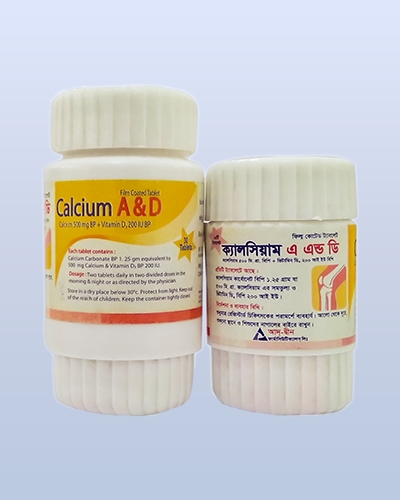ঔষধের বিস্তারিত বা বিকল্প ঔষধ জানতে ঔষধের নাম দিয়ে সার্চ দিন। যেমন- Napa বা Alatrol বা Amodis
Calcium A & D 500mg+200IU
TabletCalcium Carbonate [Elemental] + Vitamin D3
Ad-din Pharmaceuticals
Other Strength:
- Calcium A 500mg
Alternative:
- Aristocal D 500mg+200IU
- Calbo-D 500mg+200IU
- Ultracal-D 500mg+200IU
- Acical-D 500mg+200IU
- Caldical-D 500mg+200IU
- Reefcal-D 500mg+200IU
- Nutribon 500mg+200IU
- Bonwell-D 500mg+200IU
- Calmi-D 500mg+200IU
- Adcal D 500mg+200IU
- Calcibo D 500mg+200IU
- Carben D 500mg+200IU
- Calcin-D 500mg+200IU

Calcium A & D
Description
Calcium A & D is a combined preparation of calcium and vitamin D (Cholecalciferol) specially designed to promote bone health.
Composition
Each tablet contains Calcium Carbonate BP 1.25 gm equivalent to 500 mg of Calcium and Vitamin D3 BP 200 I.U.
Indication
Calcium A & D is used for the treatment or prevention of calcium depletion such as osteoporosis, reckrs, osteomalacia and parathyroid diseases in patients in whom dietary measures are inadequate. Conditions that may be associated with calcium deficiency include hypoparathyroidism, chronic diarrhoea, vitamin D deficiency, steatorrhea, sprue, pregnancy and lactation, menopause, pancreatitis, renal failure, alkalosis, and hyperphosphataemia. Calcium A & D can provide short-term relief of dyspeptic systems but are no longer recommended for long-term treatment of peptic ulceration.
Dosage and Administration
Adults, elderly and children above 12 years of age: 2 tablets per day, preferably one tablet in morning and another in evening.
Side Effects
Orally administered Calcium A & D may be irritating to the GI tract. It may also cause constipation, nausea, gastric pain, diarrhoea. Hypercalcaemia is rarely produced when large doses are given to patients with chronic renal failure.
Contraindication
Hypercalcaemia and hyperparathyroidism.
Hypercalciuria and nephrolithiasis
Zollinger-Ellison syndrome
Vitamin D overdose
Decalcifying tumours
Concomitant digoxin therapy (requires careful monitoring of serum calcium level)
Precaution
When hypercalcaemia occurs, discontinuation of the drug is usually sufficient to return serum calcium concentrations to normal. Calcium salts should be used cautiously in patients with sarcoidosis, renal or cardiac disease, and in patients receiving cardiac glycosides.
Use in Pregnancy and Lactation
Calcium and vitamin D3 containing drugs have been widely used in pregnancy by way of oral calcium supplementation or antacid therapy. Calcium A & D can be widely used in lactating women too.
Use in children
Children under 12 years of age should not take this preparation.
Use in Adults/Elderly:
For elderly patients with renal impairment, constipation may occur on calcium carbonate administration. For this reason, for adults, routine monitoring of serum calcium & phosphate level is necessary.
Drug Interaction
Calcium Carbonate may enhance the cardiac effects of digoxin and other cardiac glycosides, if systemic hypercalcaemia occurs. Calcium Carbonate may interfere with the absorption of concomitantly administered tetracycline preparations and in chronic renal failure modification of vitamin D therapy may be required to avoid hypercalcaemia .
Concomitant treatment with phenytoin or barbiturates can decrease the effect of vitamin-D because of metabolic activation.
Pharmaceutical Precautions
Store in a cool, dry place in controlled room temperature.
How Supplied
Calcium A & D tablet: Plastic container contains 30’s tablets.
এই পাতাটি ৫২০ বার দেখা হয়েছে
রাজডক কী?
ফ্রী সদস্য হোন Click Here
ডাক্তার হিসাবে যোগদান করতে Click Here
নার্স / টেকনোলজিস্ট হিসাবে যোগদান করতে Click Here
ফ্রী সদস্য হোন Click Here
ডাক্তার হিসাবে যোগদান করতে Click Here
নার্স / টেকনোলজিস্ট হিসাবে যোগদান করতে Click Here

